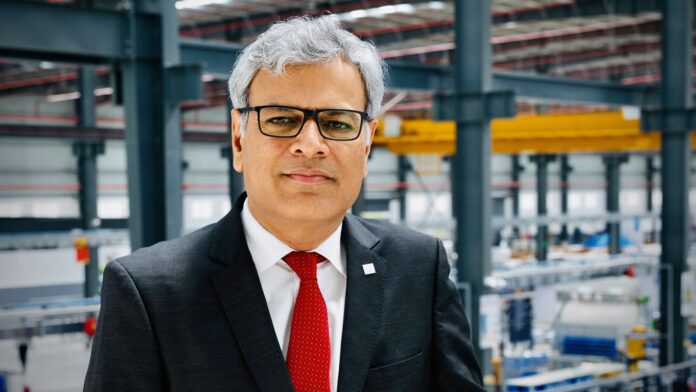Digitalisation will drive furniture production in India as manufacturers focus on efficiency and sustainability. Besides, the import-export equation will reverse, as Indian companies start designing products for overseas customers and develop a global outlook.
These are the trends that Homag India managing director Venkataramana Gorti believes will characterise the furniture industry in the coming years. Homag Group is an approximately €2-billion revenue global manufacturer of woodworking equipment, with a strong presence in India.
Gorti cites several reasons for the increase in demand for furniture during the Covid pandemic. Among them are the transformation of homes into offices and classrooms during the lockdown, the continued adoption of WFH and hybrid concepts by the service industry, a rise in office space uptake, and the shift of offline education to a physical-plus-digital mode. The expansion of medical infrastructure and revival of the hospitality sector too have boded well for the furniture industry in India.
It is worth noting that the Government of India’s nodal foreign investment agency Invest India valued the domestic furniture market at $17.4 billion in FY21. It predicted it will reach $37.7 billion by 2026, growing at a double-digit CAGR of 13.37 per cent during 2020-2026.
According to Invest India, the main drivers for furniture consumption in India are:
- 40% of India’s population will be living in urban areas by 2025, up from 31% in 2010, and will account for more than 60% of consumption.
- Consumption expenditures will rise by a factor of three to reach $4 trillion by 2025.
- There will be a 2.5x increase in income per capita from 2016 to 2027.
- The proportion of nuclear households has reached 70 per cent and is projected to increase to 74 per cent by 2025. They spend 30 per cent more per capita than joint families.
Recognising these trends, Gorti asserts that factories will have to be digitalised rapidly in the coming years. “Businesses are becoming more dependent on e-commerce, where price and service are key differentiators. Demand forecasting and production planning have become important functions without which it is not possible to retain customers. Besides, customers are asking for products that are made using safe machines, and environmentally conscious processes and materials. Such complex operations cannot be sustained unless real-time data is available about raw material consumption, machine efficiency, energy demand, downtime, production planning, etc.”
ALSO READ: India Kitchen Congress to be held on April 6th
He adds, “While e-commerce platforms are making it easier for suppliers to discover and deal with the remotest of customers, the business environment is fiercely competitive. A manufacturer is no longer in full control of the business or the customer since he is part of an elongated supply chain. The manufacturer needs to be reliable, flexible enough to cater to unique demands, and able to offer greater customisation without compromising on quality.”
Even project-driven demand for furniture is faced with complexities and challenges, he says. “Customers today want immediate estimates and prototypes, along with data-based commitments about performance and longevity.”
The new paradigm in furniture manufacturing, therefore, is the digitalisation of key processes such as machine optimisation, efficiency assessment, material handling, and remote monitoring.
For instance, it is possible to assess the overall equipment efficiency (OEE) of a machine by digitally monitoring its availability (predictable maintenance), quality (consistency of production) and efficiency (output, idling time). Digitally controlled machines can also optimise the consumption of raw materials through self-correction. Digital twinning allows for the simulation of a machine set up right down to the production data, even before the actual machine is installed.
“At Homag we are witnessing robust demand for digital equipment, both for capex as well as greenfield ventures. Digital solutions usually have an RoI of 12-18 months, but more importantly, they help to increase business by 5x-10x. I have found their acceptance more among the new generation of investors which is tech savvy and innovative.”
The government has identified furniture as one of the champion categories, which can be taken across the globe under the ‘made in India’ label. It is building huge industrial parks dedicated to this industry, which will house all players along the value chain in proximity, right from raw materials to components and allied services, to the finished products and their logistics. A 1,156-acre furniture park was launched in Tuticorin in March 2022. The Tamil Nadu government has made an initial outlay of Rs 1,100 crore for developing 500 acres in the first phase. Other such parks are being planned in the Bhuj region of Gujarat and central India.
It is also expected that a Production Linked Incentive (PLI) scheme will be introduced under Atmanirbhar Bharat 2.0, possibly in the Union Budget 2023. All this to make India a global hub for furniture manufacturing and place it among the top three countries in the world.
Gorti says that Homag’s industry 4.0 solutions are geared to prepare manufacturers for emerging opportunities within India as well as in global markets. “We have invested substantially to cater to the expected growth, by establishing a new facility in Bengaluru where we can expand our output 4x-5x. Our India facility is also the R&D and product development hub for Homag’s global operations, as well as the service hub for the Asia Pacific region.”
Venkataramana Gorti will be moderating a panel discussion on the topic of ‘Manufacturing for Flexibility and Efficiency’ at India Kitchen Congress on April 6 in New Delhi.


